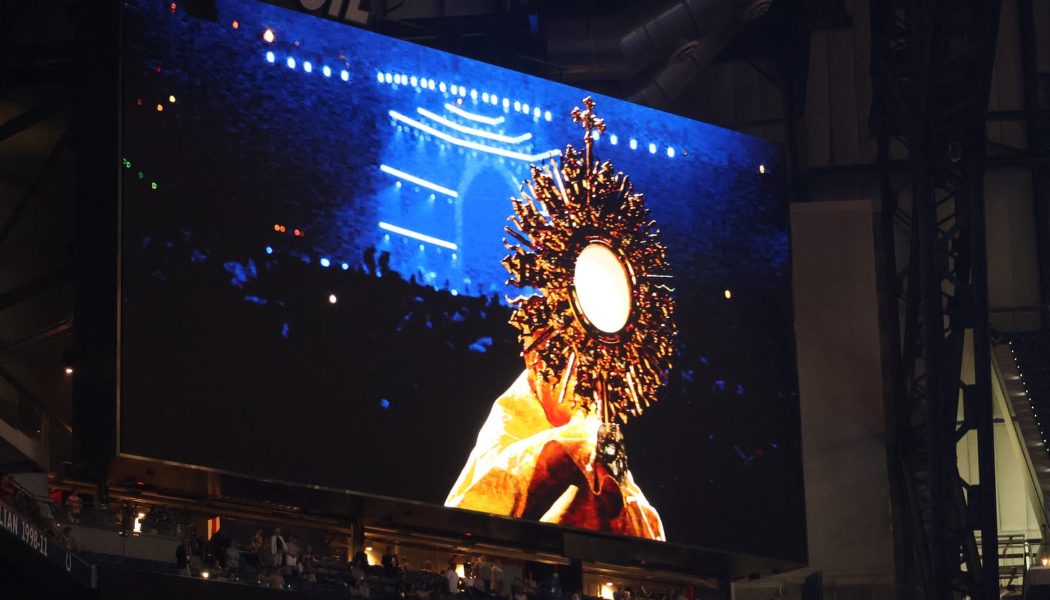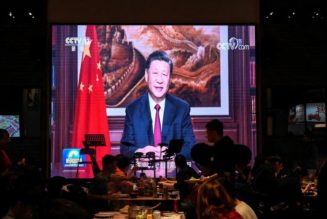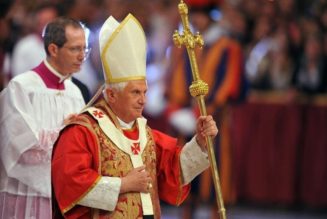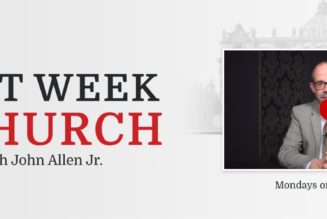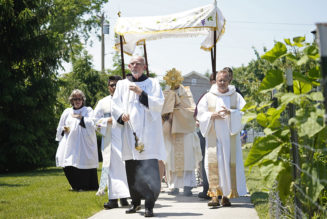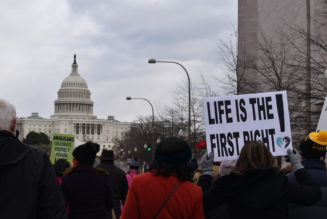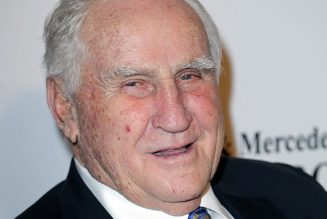As the National Eucharistic Congress concluded Sunday, it was easy to hear Catholics in Indianapolis comparing the five-day event favorably to 1993’s World Youth Day in Denver, Colorado, and suggesting that the Congress could have an impact on the U.S. Church at the same scale as the historic Denver gathering.

World Youth Day 1993 is widely credited with sparking a wave of priestly and religious vocations in the Church, and catalyzing a new apostolic and evangelical energy among a generation of practicing young American Catholics.
Comparing the Congress to World Youth Day is meant to describe the five-day gathering last week as a thorough success.
Indeed, the Congress has been broadly acclaimed as a success beyond expectation. While staffers and volunteers noted persistent logistical challenges, as did journalists trying to cover the event, attendees, ranging from laity to bishops, have told The Pillar frequently that the Eucharistic Congress, and especially its liturgical elements, were beautiful, meaningful, and potentially life-changing.
Most often recognized by attendees was the Eucharistic procession, reportedly attended by 60,000 people, and the nightly holy hours in Lucas Oil Stadium, in which bishops could be seen crying, and attendees spent an hour kneeling on concrete, as the Blessed Sacrament was exposed.
One holy hour in particular, at which a litany for healing was recited, has been frequently mentioned by attendees as a rich and meaningful experience.
“Jesus, heal my heart with your love,” the stadium prayed, “for the times I’ve been rejected… forgotten … [or] let down by the Church.”
Among priests, the Congress has been widely praised for its clerical track, in which laity, priests, and bishops, including organizer Bishop Andrew Cozzens, spoke with priests candidly about struggles in their vocations, and about turning to the Lord.
In short, the Congress has been praised by many participants using a phrase organizers have offered for months — that the event was a “generational moment” of renewal for U.S. Catholics.
But whether the event was just a really good retreat, or will be remembered in the same way as 1993’s World Youth Day, depends a lot on what happens next — and on decisions made by organizers, participants, and diocesan bishops themselves.
—
When Congress chairman Bishop Andrew Cozzens stopped into a bar close to the stadium Thursday night, to grab a drink and say hello to listeners of The Pillar Podcast, the prelate was met with a standing ovation from the 400 or so Catholics in the bar. The ovation seemed to last for minutes.
He got the same kind of ovation after remarks at the closing Mass of the Congress, although that time, it was from some 40,000 pilgrims in Lucas Oil Stadium.

And when Cozzens walked through the Congress, clad always in house cassock, zucchetto, and pellegrina, he was stopped nearly everywhere by people — clerics, religious, and laity — wanting to thank him, or congratulate him, or both.
The Pillar spoke with bishops during and after the Congress, most of whom agreed that for Cozzens, the Congress will be regarded as something of a triumph, in which the bishop’s big vision overcame doubters and critics to accomplish an event the entire Church will be proud of.
Bishops also mentioned that Cozzens managed to walk a tightrope during the event — he led when it was appropriate, for example, at the first Holy Hour, and during the Eucharistic procession — but he also yielded to other prelates, inviting them to take prominent liturgical roles, and to share with him in leadership.
“It was his show, in the sense that he obviously led this,” one bishop told The Pillar, “but it wasn’t the Andrew Cozzens show. He just didn’t turn things into that.”
Several bishops told The Pillar they thought that Cozzens’ success at the event would translate into a desire for bishops to see him take more leadership roles — while few mentioned the prospect of Cozzens taking a bigger diocesan see, especially given the politics of episcopal appointments, several wondered aloud whether the bishop “might be willing” to take on a more prominent role at the bishops’ conference.
That could see Cozzens, who is only 55, eventually floated as a potential candidate to lead the bishops’ conference in 2025, when Archbishop Timothy Broglio’s term of office expires — or see him elected vice president at that time, with the prospect of becoming president in 2028, well ahead of the next planned Eucharistic Congress.
Cozzens has, to date, generally expressed docility toward the prospect of being chosen for leadership positions, while seeming to avoid even the appearance of campaigning for them.
But whether the bishop does eventually take up a formal leadership position in the bishops’ conference, he is sure to be seen as a leader among a large swath of the 200 bishops who attended the Congress.
“He is top of my list,” one bishop told The Pillar Sunday.
Several bishops “really see this as a sign he could do more,” another bishop explained.
Given Cozzens’ penchant for big-picture, evangelically-driven thinking, his growing stature among the episcopate could mean that more big, risky, missionary-minded ideas will get support from American bishops.
That could also mean a big lift for a project important to Pope Francis — in press conferences during the Congress, Cozzens repeatedly told journalists that the planning process for the event was “synodal,” and was modeled mostly on an archdiocesan synod he’d helped with in the Twin Cities.
Cozzens described synodality in that context as an effort to hear from lots of Catholics about what a Eucharistic Revival might look like, and then to actively invite them to periods of prayer — punctuating meetings with chapel visits — during planning sessions.
Along the way, Cozzens appointed lay people to key and influential positions in the Congress team, finding ways to ensure the event demonstrated the kind of collaboration between clergy and laity called for by Vatican Council II.
Given that some bishops who were critical of the Eucharistic Congress have also been champions of the “synodal style” of Pope Francis, it will be ironic if Cozzens’ leadership of the event becomes known as the catalyst for a more frequently “synodal style” in American episcopal ministry.
But the bishop has encouraged his peers along those lines, and, given the impression he made in Indianapolis, many of them seem likely to listen.
Still, the real and lasting effect of Denver’s World Youth Day was not so much related to episcopacy, as to the laity.
Many of the largest and most active apostolic movements in the Church in the United States trace their origins to the experience of World Youth Day in Denver. So too do hundreds of priests and religious. And indeed, the presence and flourishing of modern ecclesial movements, and a host of growing religious orders, can also be traced to 1993’s World Youth Day.
But none of those things were directly foreseen by World Youth Day’s organizers.
Instead, the young people who went to World Youth Day heard a message — in that case, “do not be afraid to be saints,” and they ran with it. The organizational infrastructure of World Youth Day soon faded into the background, its main organizer soon became a parish priest, and the vitality of the event was carried on organically by Catholics discerning, in small groups or as individuals, what God wanted them to do.
It’s not clear whether the vitality of the National Eucharistic Congress will be taken up in quite some way.
But organizers — the officials of National Eucharistic Congress, Inc — say they believe their corporation can continue to be a catalyst for renewal in the life of the Church. In addition to planning a Eucharistic pilgrimage next summer, and beginning early stage plans for a Congress in the 2030s, organizers told The Pillar they’re also looking to see what programs and events they can plan to promote the idea of “Eucharistic Revival” in the Church.
That could prove to be effective. But it could also mean that the memory and experience of the Eucharistic Congress is shaped by its organization entering a crowded conference-and-curriculum market in the Catholic Church.
And to some observers, seeing the Congress mission diluted into another “brand” or player in that space might well cheapen or diminish the experience of the Eucharistic Congress as a stand-alone, generational experience that could catalyze creative thinking and action from many corners of the Church.
In short, Congress organizers run the risk after their event of so broadening the focus of their mission that the contribution the Congress offered — particularly because it was done in the name of the Church herself — might seem less about sparking broad revival, and more about building a brand or trying too hard to capitalize on their success.
On the other hand, if Congress organizers focus their mission — perhaps on ongoing Eucharistic pilgrimages and the future Congress itself — they might have the ability to learn a great deal from what they’ve already experienced, and set those activities up as ongoing sources of inspiration and renewal.
—
To Catholics who didn’t attend the National Eucharistic Congress, footage from the event might make them wonder what made it different from some of the big name annual Catholic conferences which take place every year across the country.
Indeed, much of the programming was the same, with many speakers quite familiar to frequent attendees of the Catholic conference circuit — although the Congress also was intentional about inviting a spectrum of speakers not always invited to such events, and about giving a prominent speaking place to the Church’s apostolic nuncio, Cardinal Christophe Pierre.
And indeed, if attendees only went to the “breakout” or “impact” sessions hosted by prominent Catholic speakers, the event might have seemed much like other Catholic conferences.
But what made the Eucharistic Congress unique is that those speakers were really, it seems clear, the programming between the central and main events of the Congress, and not the main event themselves.
Instead, the scheduling choices made by organizers made clear that for them, the Eucharistic liturgies and devotions were the central element of the Congress — in Lucas Oil Stadium, the Blessed Sacrament, in a monstrance, on an altar, surrounded by lit candles, was the only thing to take center stage.
That might well become the lesson seen ultimately to be most fruitful for the Church — that if the Eucharistic Congress is to have the same kind of long-lasting impact as World Youth Day, it’s because the Church learned there to lead with her sacred liturgy, to begin with an invitation to worship Almighty God.

It remains to be seen whether that lesson will be learned, or how it will be implemented. But if Congress organizers had a message for the Church in the United States, it seemed to be this: That the Eucharistic liturgy should be the source and summit of the Christian life.
Not original to the Congress, not new, and often recited as a platitude — but if lived, that message may well be the spark of deep renewal, and of Eucharistic revival.
Comments 38
Services Marketplace – Listings, Bookings & Reviews
